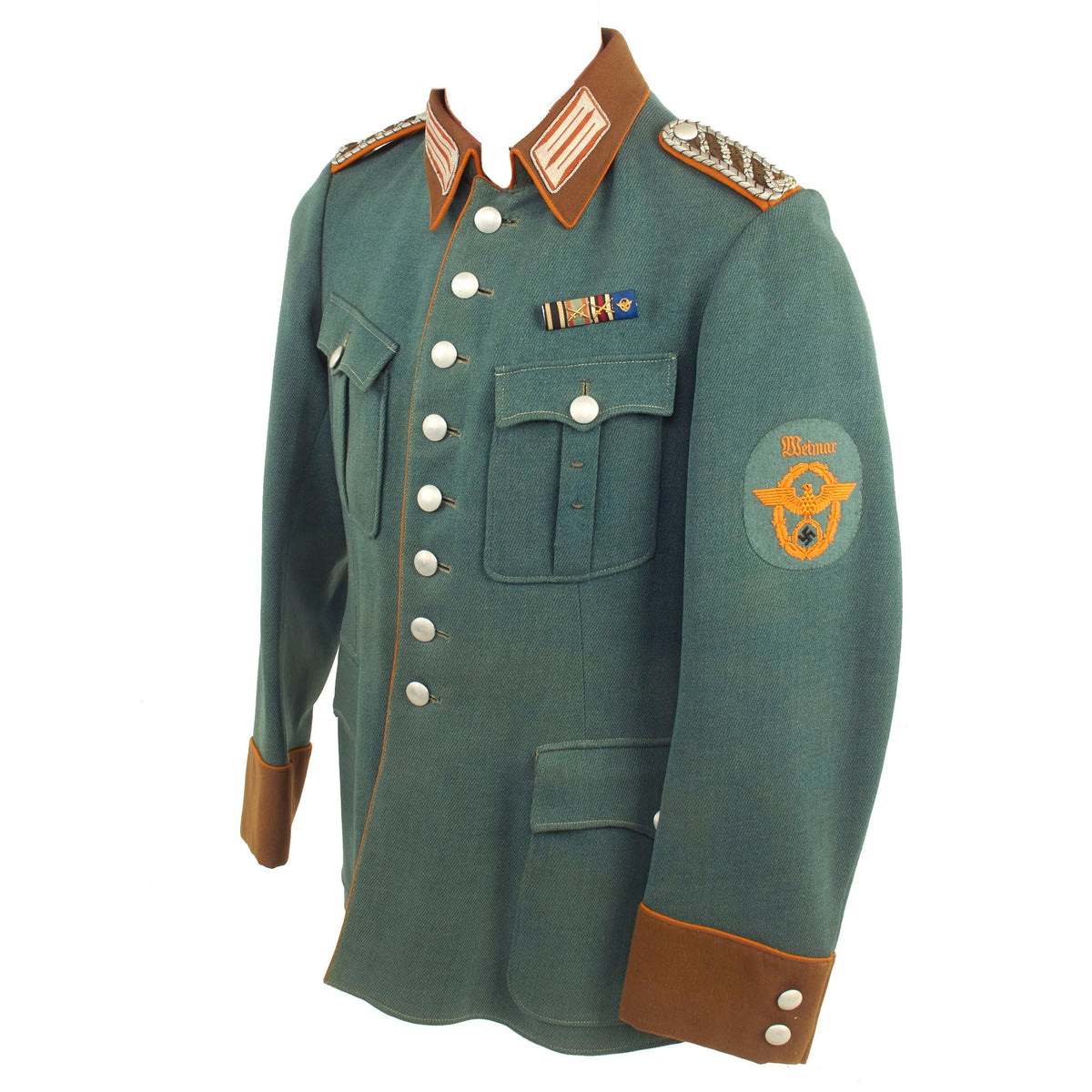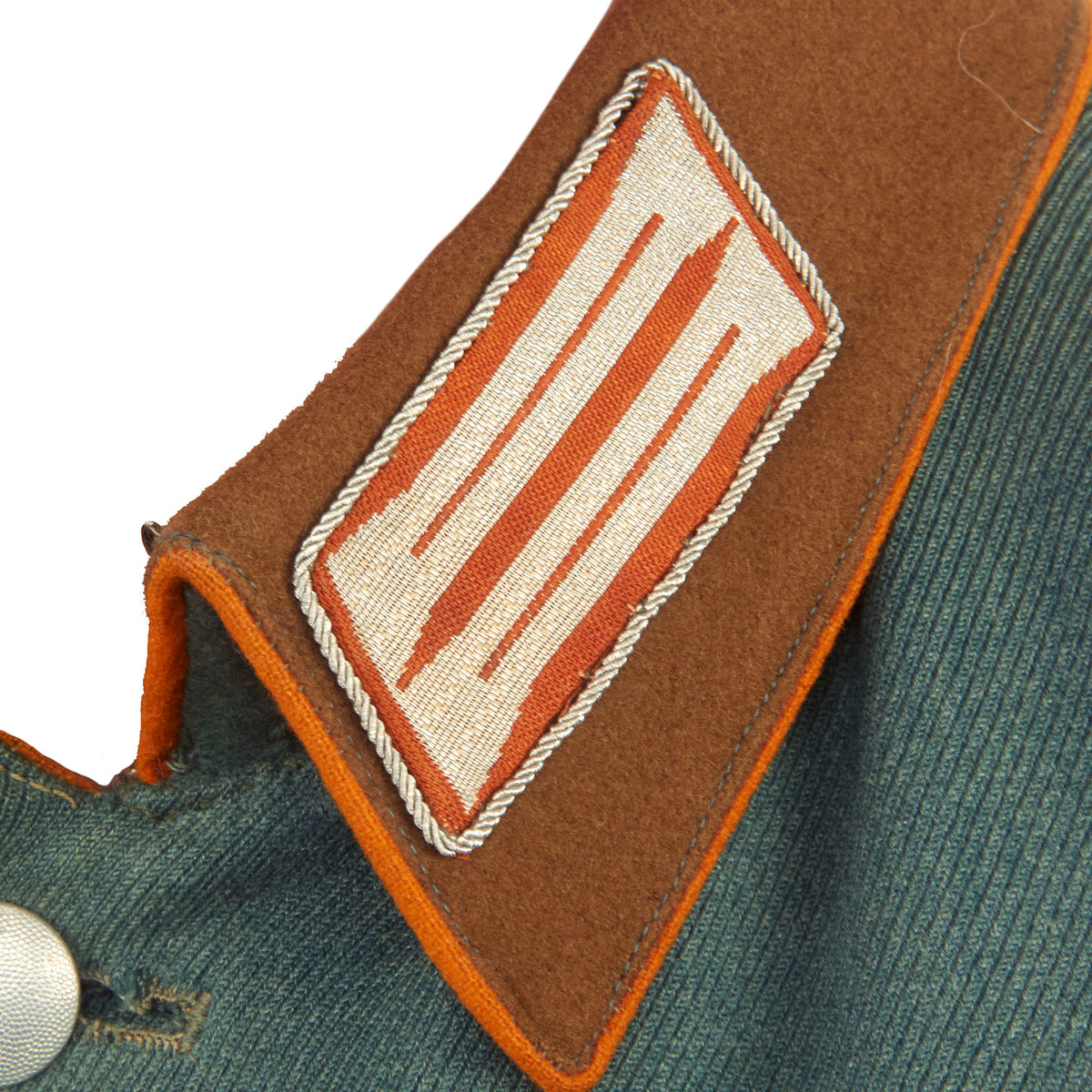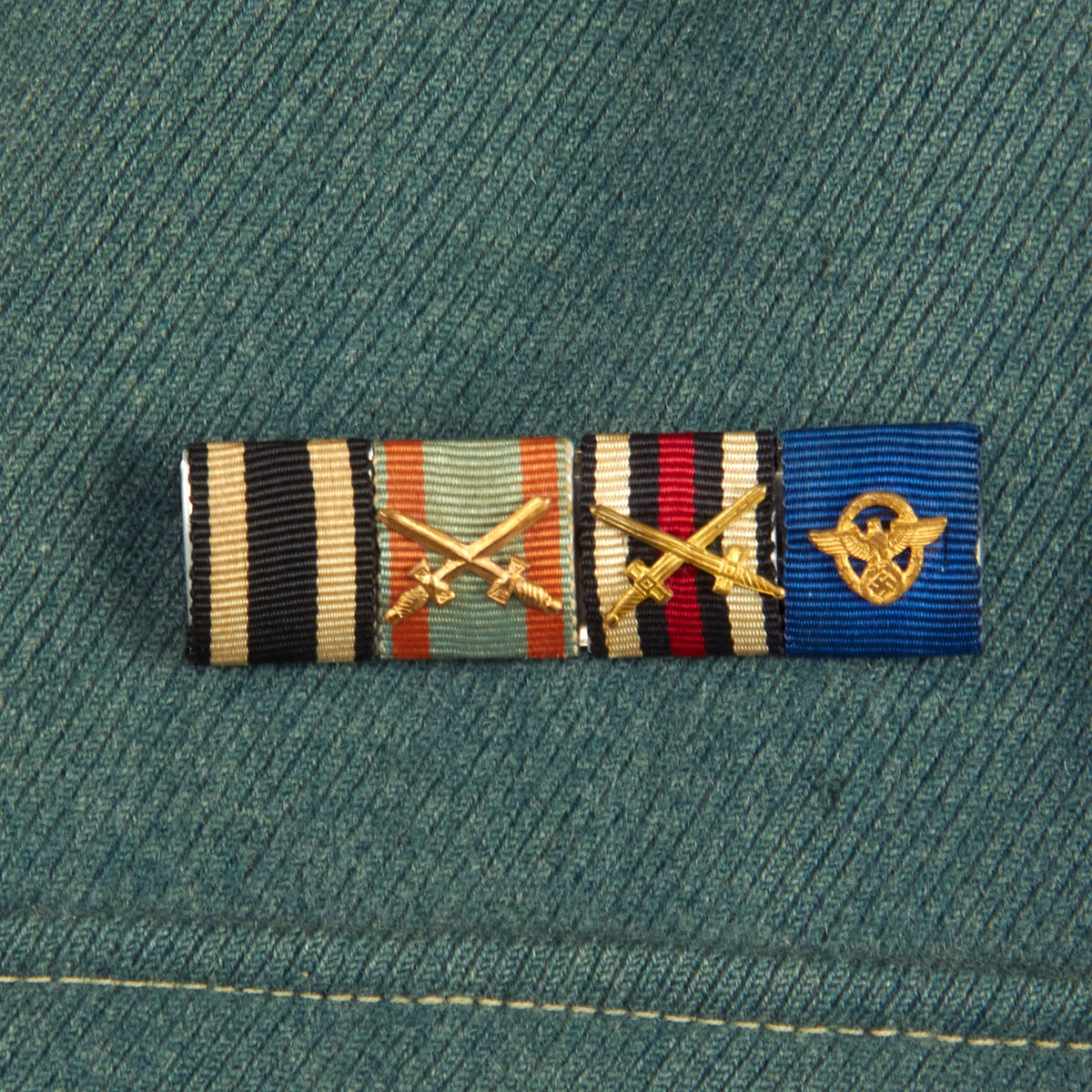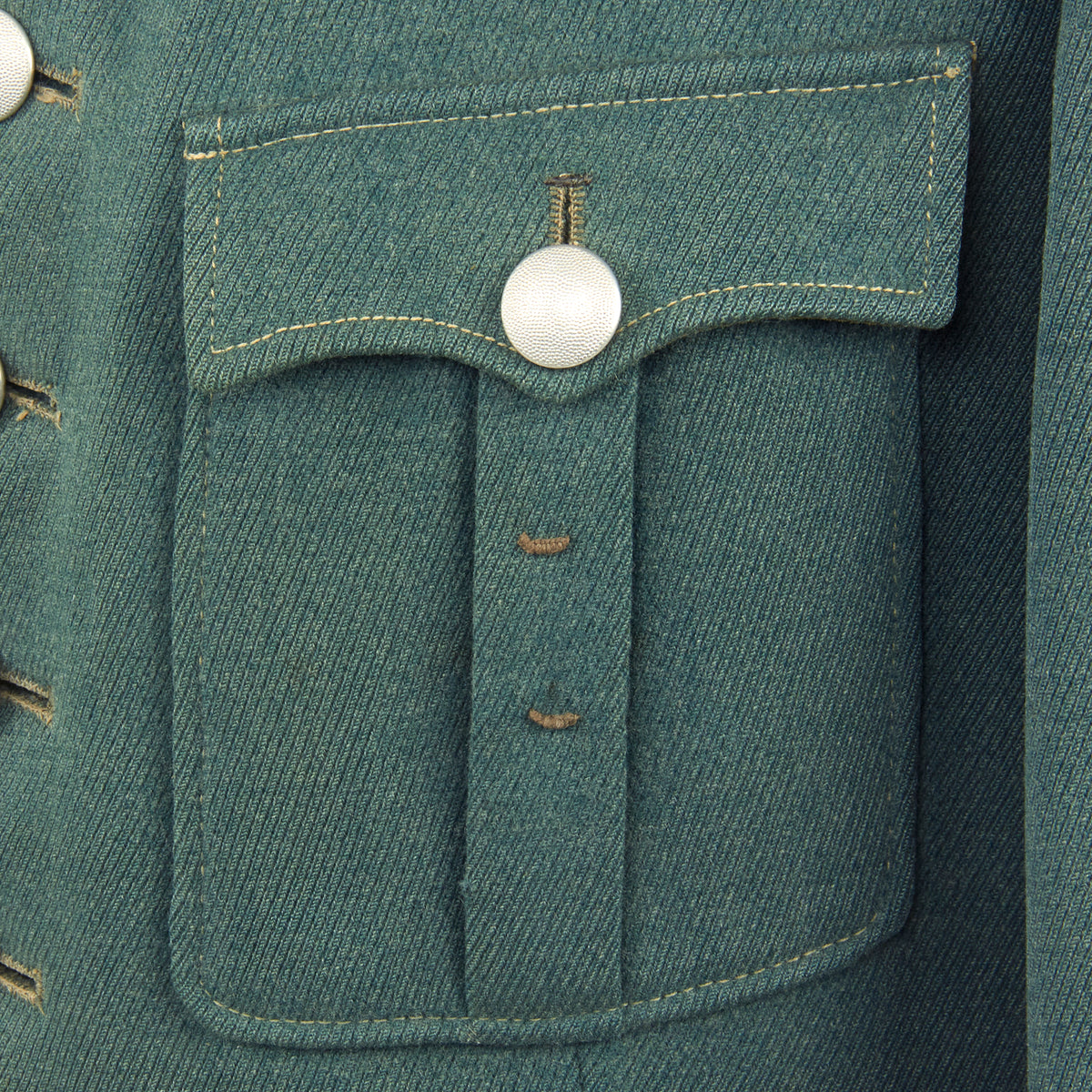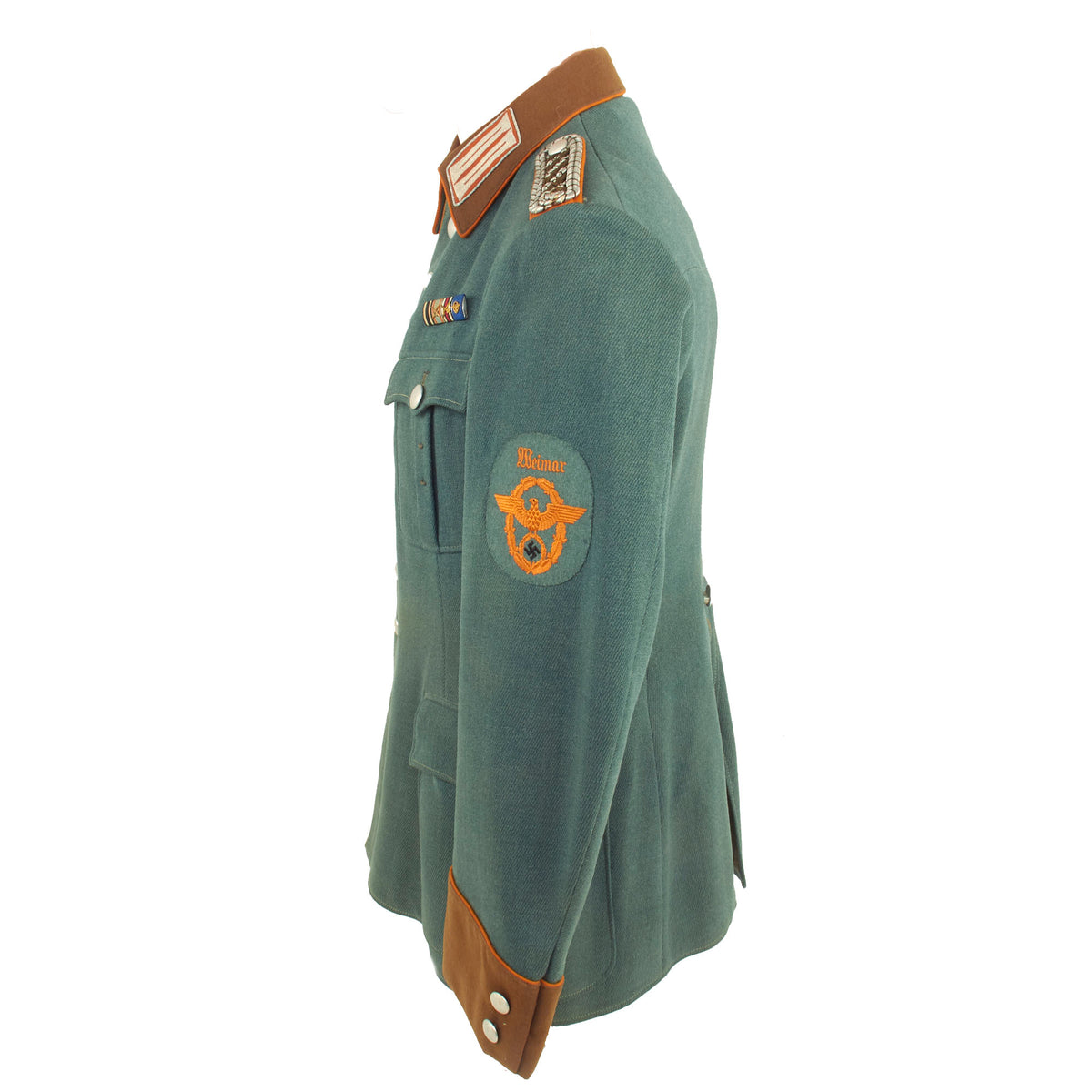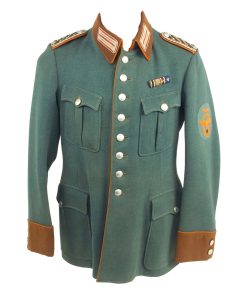Original German WWII Gendarmerie Rural Police Weimar Area Meister NCO’s M36 Field Tunic with WWI Era Medal Bar Original Items
$ 1.195,00 $ 298,75
Original Item: Only One Available. The Ordnungspolizei, abbreviated Orpo, meaning “Order Police”, were the uniformed police force in NSDAP Germany from 1936 to 1945. The Orpo organization was absorbed into the NSDAP monopoly on power after regional police jurisdiction was removed in favor of the central government (“Reich-ification”, Verreichlichung, of the police). The Orpo was controlled, nominally by the Interior Ministry but its executive functions rested with the leadership of the SS until the end of World War II. Owing to their green uniforms, Orpo were also referred to as Grüne Polizei (green police). The force was first established as a centralized organization uniting the municipal, city, and rural uniformed police that had been organized on a state-by-state basis. Eventually the Police were divided into eight assorted branches of service, with each branch having a distinguishing truppenfarbe, (Branch of service color) that was displayed on the uniforms including the piping on the visor caps.
The Gendarmerie (state rural police) were tasked with frontier law enforcement to include small communities, rural districts, and mountainous terrain. They were issued uniforms with Orange-gelb (Orange-yellow) truppenfarbe piping and insignia. With the development of a network of motorways or Autobahnen, motorized gendarmerie companies were set up in 1937 to secure the traffic. The German Police had no enlisted ranks, with the lowest rank being an Unterwachtmeister (Junior Watch Master), which was equivalent to the German army rank of Unteroffizier. The highest NCO rank was that of the Meister (Master), or Warrant Officer, which did not have an armed forces equivalent, but was higher than an army Oberfeldwebel (Master Sergeant).
This lovely Gendarmerie Rural Police Meister NCO’s M-36 tunic is made of fine quality police-green wool gabardine twill, and in form is more or less identical to the Army Heer tunic except for the colors used. There are no maker or issue markings that we can see, but we assume that it was a department issued tunic, and not private purchase. The tunic features four pockets with scalloped flaps and pebbled aluminum buttons, and has an eight button front closure, with two “hook and loop” fasteners for the collar. The buttons on the tunic are sewn directly to the fabric, not attached with metal circlips, and all are in great shape. They all look to have issue markings stamped onto the back.
The interior is lined with lovely olive tan cotton & rayon twill blend, with lightweight white striped rayon lining the sleeves. There is an interior slash pocket right next to the button closure on the inside left breast. There is just a bit of wear on the interior, with no tears or other damage that we can see. There is the usual slot for a dagger or bayonet to hang out of the lower left pocket.
The collar is wrapped in a brown “badge cloth” wool, has police NCO’s litzen collar patches on each side, which are machine woven from silver bullion thread with a Police Orange-gelb (Orange-yellow) background, the Truppenfarbe (Troop Color) of the Gendarmerie. The collar is in excellent shape, showing almost no areas of wear. This would usually be the first place on the uniform to show wear, so it definitely does not look to have seen extensive use. The sleeve cuffs are covered with the same brown cloth as the collar, and the cuffs and front closure are piped in orange-yellow as well.
As this is a Police tunic, there is no Wehrmachtadler breast eagle, and instead the uniform has a high quality machine embroidered Civic Police Eagle badge sewn to the left sleeve. The insignia is sewn using the same Orange-yellow color thread, with a black swas, and above this is Weimar, indicating that the owner was stationed in the rural area surrounding the city of Weimar It is only sewn to the top layer of fabric, indicating that it was installed when the uniform was being fabricated.
The “sew-in” style NCO schulterklappen (shoulder boards) of this tunic are unique to the rank of Meister, and are bordered with a single row of of fine silver flatware “Russia Braid” double piping around the edge, with brown chevrons woven into the design. Inside this is a braid of brown double piping woven together with the silver double piping with the same brown chevrons, giving them a lovely look. They have the correct orange-yellow base material and piping around the edges for the Gendarmerie.
Above the left pocket is a small three award medal bar from the WWI Era, showing that the soldier received the Iron Cross 1918 2nd Class EKII, the – Austro-Hungarian WWI Pro Deo et Patria Military Medal 1914-1918 for Combatants with Swords, the German WWI Honor Cross of the World War 1914/1918 (Hindenburg Cross) with Swords, and the WWII Era 25 Year Police Long Service award. There are also some thread loops on the pocket underneath, so there are awards that the German soldier removed, probably to put on another uniform.
Overall condition on this tunic is excellent with no noticeable damage or moth marks. This is a great example of a genuine WWII German Gendarmerie (Rural Police) Meister’s uniform!
Approximate Measurements:
Collar to shoulder: 9″
Shoulder to sleeve: 25”
Shoulder to shoulder: 14.5”
Chest width: 17″
Waist width: 17″
Hip width: 22″
Front length: 30″
Terms such as M40 and M43 were never designated by the Wehrmacht, but are names given to the different versions of the Model 1936 field tunic by modern collectors, to discern between variations, as the M36 was steadily simplified and tweaked due to production time problems and combat experience.
Field Tunic (Feldbluse) Model 1936
When the NSDAP came to power in early 1933 the Reichswehr, the armed forces of the Weimar Republic, were near the end of a two-year project to redesign the Army Feldbluse (field-blouse). Beginning in that year the new tunic was issued to the Reichsheer and then the rapidly growing Wehrmacht Heer, although minor design changes continued to be made until the appearance of the standardized Heeres Dienstanzug Modell 1936. The M36 tunic still retained the traditional Imperial and Reichswehr uniform color of grey-green “field gray” (feldgrau) wool, but incorporated four front patch pockets with scalloped flaps and pleats (on Reichswehr tunics the lower pockets were internal and angled). The front was closed with five buttons rather than the previous eight, and the collar and shoulder straps were of a dark bottle-green instead of the Reichswehr grey. Compared to the Weimar-era uniforms the skirt of the feldbluse was shorter and the tailoring was more form-fitting due to Germany’s adoption of mechanized warfare: soldiers now spent much time in the confined space of a vehicle and a shorter jacket was less likely to pick up dirt from the seats. It also included an internal suspension system, whereby a soldier could hang an equipment belt on a series of hooks outside of the tunic. These hooks were connected to two straps inside the lining, which spread the weight of equipment without having to use external equipment suspenders. The M36 was produced and issued until the very end of the war, though successive patterns became predominant.
SS field uniforms were of similar appearance externally but to fit their larger patches had a wider, feldgrau collar, and the lower pockets were of an angled slash type similar to the black or grey SS service-dress. The second button of an SS Feldbluse was positioned somewhat lower, so that it could be worn open-collar with a necktie. Due to supply problems the SS were often issued army uniforms.
Fast Shipping with Professional Packaging
Thanks to our longstanding association with UPS FedEx DHL, and other major international carriers, we are able to provide a range of shipping options. Our warehouse staff is expertly trained and will wrap your products according to our exact and precise specifications. Prior to shipping, your goods will be thoroughly examined and securely secured. We ship to thousands clients each day across multiple countries. This shows how we're dedicated to be the largest retailer on the internet. Warehouses and distribution centres can be located throughout Europe as well as the USA.
Note: Orders with more than one item will be assigned a processing date depending on the item.
Before shipping before shipping, we'll conduct a thorough inspection of the items you have ordered. Today, the majority of orders will be delivered within 48 hours. The delivery time will be between 3-7 days.
Returns
The stock is dynamic and we cannot completely manage it because multiple stakeholders are involved, including our factory and warehouse. So the actual stock may alter at any time. It's possible that you may not receive your order once the order has been made.
Our policy is valid for a period of 30 days. If you don't receive the product within 30 days, we are not able to issue a refund or an exchange.
You can only return an item if it is unused and in the same state as the day you received it. You must have the item in its original packaging.
Related products
Uncategorized
Uncategorized
Uncategorized
Uncategorized
Uncategorized
Uncategorized
Armoured Fighting Vehicles of the World: AFVs of World War One (Hardcover Book) New Made Items
Uncategorized
Uncategorized
Uncategorized
Uncategorized
Band of Brothers ORIGINAL GERMAN WWII Le. F.H. 18 10.5cm ARTILLERY PIECE Original Items
Uncategorized
Armored Burgonet Helmet & Polearm from Scottish Castle Leith Hall Circa 1700 Original Items
Uncategorized
Uncategorized
Uncategorized
Uncategorized

